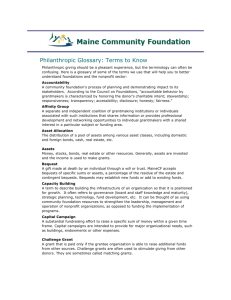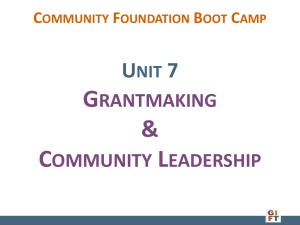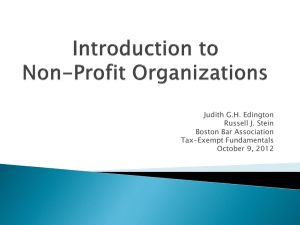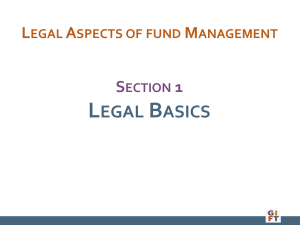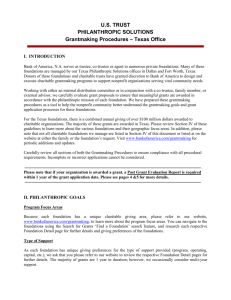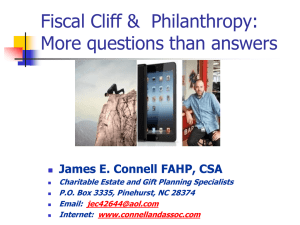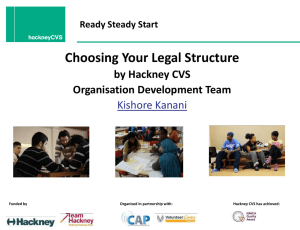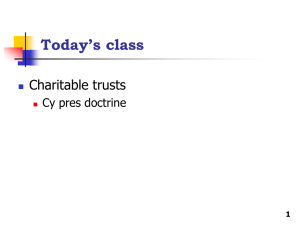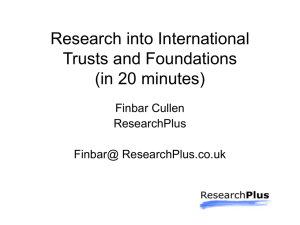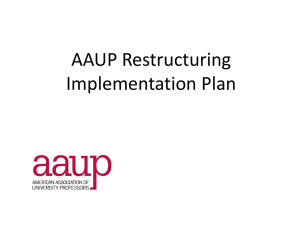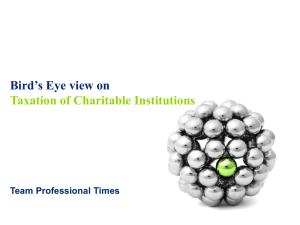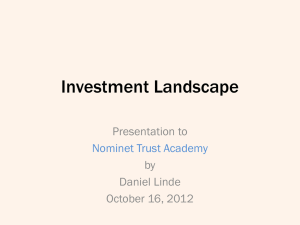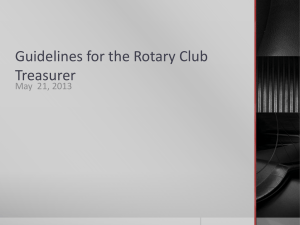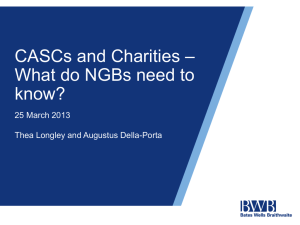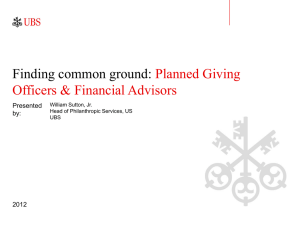GIFT Boot Camp Unit 1 - CF Basics-2014
advertisement
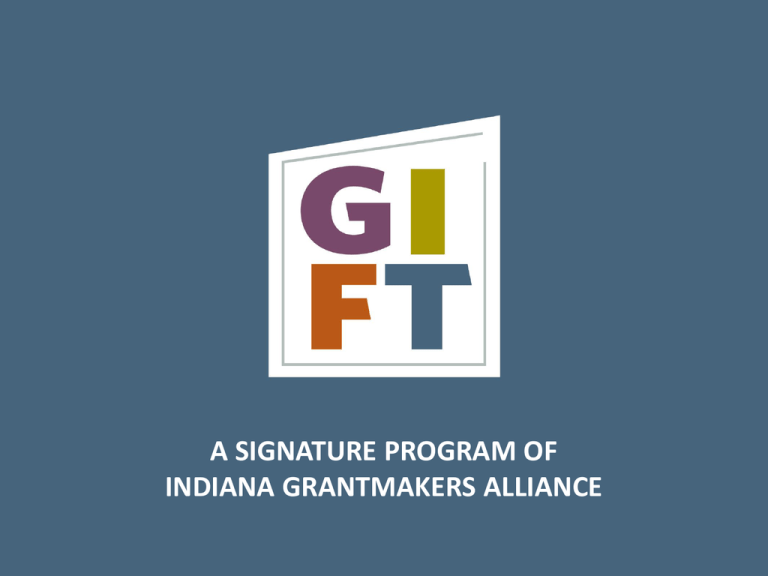
A SIGNATURE PROGRAM OF INDIANA GRANTMAKERS ALLIANCE COMMUNITY FOUNDATION BOOT CAMP UNIT 1 COMMUNITY FOUNDATION BASICS DEFINITION, ROLES AND HISTORY DEFINITION OF A U.S. COMMUNITY FOUNDATION Nonprofit, tax exempt under section 501(c)3 Goal of building permanent endowment funds Independent, nonsectarian governing body Focused within a defined geographic area Publicly supported by many unrelated donors Grantmaking is not limited by field of interest or to specific populations ADDITIONAL CHARACTERISTICS OF U.S. COMMUNITY FOUNDATIONS Responsible and accountable to the community Governing body representative of the area served Has a well-defined, articulate mission Meets public support test Variance power COMMUNITY FOUNDATIONS – THE REALLY BIG PICTURE GOVERNING BOARD Sets Goals, Direction, Policy STAFF Implementation, Operations DONORS Individuals Corporations Private foundations Charitable organizations GIFTS come in different forms Cash Appreciated Securities Real Estate Closely held securities Personal property Life insurance Retirement assets Wills and bequests These are community foundation ASSETS GIFTS are placed into a FUND Unrestricted Donor Advised Field of Interest Designated Scholarship Agency Funds are governed by the FUND AGREEMENT INVESTMENTS PAYOUT/DISTRIBUTIONS Investment Policy Spending Policy Grants for charitable activities Administrative fees to support CF operating budget Community foundation FISCAL RESPONSIBILITY Fulfilling DONOR INTENT Through this activity, a community foundation gains connections, visibility, knowledge, creditability, influence and resources to provide COMMUNITY LEADERSHIP COMMUNITY FOUNDATION ROLES Permanent Endowment Building • • • • Develop relationships with donors Invest and protect the principal of donor gifts Distribute earnings from these gifts based on charitable intent of the donor Build a permanent resource for the future Broad Flexible, Grantmaking • • • • • Understand community needs Re-direct charitable dollars over time and as community needs change Strengthen existing organizations Bring new and innovative charitable organizations into existence Can be proactive or responsive Community Catalyst • • Convener, facilitator and collaborator Promoter of philanthropy HISTORY OF COMMUNITY FOUNDATIONS 1914 - The first community foundation was established in Cleveland, Ohio. Within five years, community foundations formed in places like Indianapolis, Chicago, Boston, Milwaukee, and Minneapolis. 1969 - the Tax Reform Act of 1969 contributed to the rapid growth of community foundations as private foundations becoming more strictly regulated and community foundations became a more attractive option for many donors. In the 1990s, commercial financial services firms, such as Schwab, Fidelity and Vanguard, began to offer donoradvised funds. HISTORY OF COMMUNITY FOUNDATIONS Historically, the tradition was that donors left bequests to community foundation endowments. In recent years there has been tremendous growth in donor advised funds (DAFs) and other funds which support more active giving, where living donors advise the foundation about granting the funds. There are over 800 community foundations in the United States and about 1,400 existing around the world. PROVIDED BY CF INSIGHTS GIFT HISTORY Created in 1990 by Lilly Endowment Inc. Establish permanent charitable assets across Indiana Support local communities and build civic participation Series of 5 grant phases over first several years Additional programs – Taking Stock, CAPE, SRD, interns Unique program in community foundation world Currently Indiana has 74 legal entities covering all counties in Indiana All Indiana CFs - Over $2 billion in assets TAX CODE BASICS WHAT DOES CHARITABLE MEAN? Charitable (generous) IRS Charitable (tax deductible) Nonprofit Charitable TAX-EXEMPT ORGANIZATIONS – 501(C) Charitable – 501(c) (3) Civic leagues – 501(c)(4) Business leagues, chambers of commerce, real estate boards – 501(c)(6) Social, recreational clubs – 501(c)(7) Fraternal benefit societies & associations – 501(c)(8) Cemetery associations – 501(c)(13) Credit unions – 501(c)(14) Veterans organizations – 501(c)(19) Note: These types of organizations may have a related 501(c)(3) organization (foundation) for its charitable activities. CHARITABLE – 501(C) (3) From US Tax Code…”organized exclusively for religious, charitable, scientific, testing for public safety, literary, or educational purposes, or to foster national or international amateur sports competition, prevention of cruelty to children or animals…” Contributions are deductible as itemized charitable deductions and also qualify for the gift tax and estate tax charitable deductions CHARITABLE – 501(C) (3) 1. Public charities (other than private foundation) under Code section 509(a) • Traditional public charities – 509(a)(1) – hospitals, educational organizations, churches and governmental units. Community foundations are this type of charity. • Publicly-supported organizations – 509(a)(2) – receive at least 1/3 total support from governmental units, general public and/or fees from related activities and not more than 1/3 from investment income (the “public support test”). Supporting organizations – 509(a)(3) – take their tax status from the charity(ies) they support 2. Private foundations Section 501(c) – Tax Exempt Organizations Public Charities 501(c)(3) Mutual Benefit Orgs • 501(c)(4)-Civic leagues • 501(c)(6)-Business leagues, chambers of commerce, real estate boards • Others Traditional Charities 509(a)(1) • • • • • Hospitals Schools Churches Government Community foundations Private Foundations 501(c)(3) Publicly Supported Charities 509(a)(2) • One-third of charity’s support is from the general public Supporting Organizations 509(a)(3) WHAT IS “VARIANCE POWER”? Variance Power: A distinguishing characteristic of community foundations, the variance power permits the community foundation’s governing body to redirect resources in component funds if it determines that the donor’s restriction is unnecessary, incapable of fulfillment or inconsistent with the charitable needs of the community or area served. UMIFA (UPMIFA) The Uniform Management of Institutional Funds Act (UMIFA) was a pioneering statute, adopted in 1972, providing uniform and fundamental rules for the investment of funds held by charitable institutions and the expenditure of funds donated as “endowments” to those institutions. In 2007, UMIFA was changed to include the word ‘prudent’ (UPMIFA). The UPMIFA (UMIFA in Indiana) now allowed the boards of institutions with endowment funds to spend principal of endowment funds when considering the following elements: • • • • • • • Duration and preservation of the endowment fund Purposes of the foundation and the endowment fund General economic conditions Possible effects of inflation or deflation Expected total return from income and appreciation of investments Other resources of the foundation Investment policy of the foundation PENSION PROTECTION ACT (PPA) OF 2006 Senate Finance Committee review of abuses in the charitable sector: Abuse of donor-advised funds Over-valuation of non-cash gifts Control by donors over scholarships Personal benefit by donors Misuse of supporting organizations And other problems! CONFLICT OF INTEREST Board members have a legal obligation to act in the best interest of the organization A “conflict of interest” occurs when personal interests prevent a board member from making an impartial decision Can be financial or non-financial Written conflict of interest policy ensures that public trust is not violated Policy should include procedures on • Disclosure • Recusal from discussion or voting KEY LEGAL DOCUMENTS Articles of Incorporation: A document filed with the secretary of state by persons establishing a corporation establishing the purpose of the corporation. Bylaws: Rules governing the operation of a nonprofit corporation, developed according to state law requirements. Bylaws provide the methods for selecting directors, creating committees, and conducting meetings. KEY LEGAL DOCUMENTS Minutes Official written record of the community foundation’s business. All important decisions made by the community foundation should be documented in the board minutes as stated in the National Standards section on Mission, Structure and Governance. Examples include approval of: new policies new funds changes in funds budget adoption payout percentages, etc. board member abstentions and recusals grant and scholarship recipients KEY ORGANIZING MATERIALS Strategic Plan: Sets forth direction and goals over a multi-year period; guides the development of the Annual Work Plan Annual Work Plan: Outlines specific activities and tasks that support the Strategic Plan; guides the development of the Annual Budget Annual Budget: Defines the revenue and expenses needed to accomplish the Annual Work Plan NATIONAL STANDARDS FOR COMMUNITY FOUNDATIONS The National Standards include: Definition of a U.S. Community Foundation And standards in each of these categories: Mission, Structure and Governance Resource Development Stewardship and Accountability Grantmaking and Community Leadership Donor Relations Communications *The standards referral sheet is a separate handout

